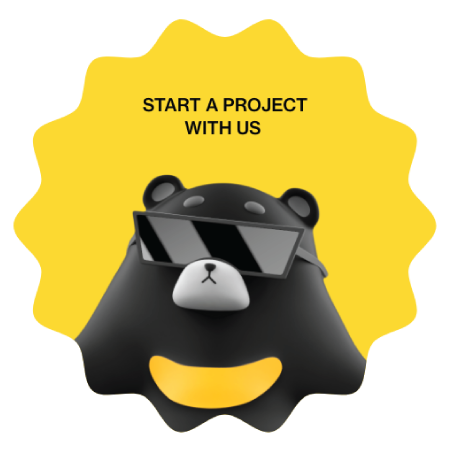UI design is the process of designing the graphical user interface of a digital product, such as a website or mobile app. It's a crucial aspect of creating user-friendly and visually appealing digital products. As technology continues to evolve, the demand for skilled UI designers continues to grow.
If you're interested in learning UI design, you're in the right place. This guide will take you through the basics of UI design, from understanding the principles of good design to mastering the tools of the trade. By the end of this guide, you'll have a solid understanding of how to create visually stunning and user-friendly interfaces. Whether you're a complete beginner or have some design experience, this guide will provide you with the knowledge and skills you need to start creating beautiful and effective digital products.
Understanding the principles of good UI design, such as simplicity, consistency, and usability
When it comes to UI design, the principles of good design can make or break a digital product. These principles include simplicity, consistency, and usability, and they are the foundation of creating user-friendly and visually appealing interfaces. Simplicity is all about keeping the design minimal and avoiding unnecessary clutter. Consistency is about ensuring that the design elements and interactions are consistent throughout the product. Usability is about making sure that the design is intuitive and easy for the user to understand and use. In this section, we will explore these principles in more detail and provide examples of how to apply them in your own designs.
Simplicity: Simple designs are easy to understand and use. They remove unnecessary elements and focus on the most important information. Simple designs are also faster to load, which can be especially important for mobile users. To achieve simplicity in your design, you can start by removing any element that does not serve a specific purpose, or that can be replaced with a simpler solution. Also, use visual hierarchy to guide the user's attention to the most important elements, and make sure the design elements are aligned and have enough whitespace.
Consistency: Consistency is important in UI design because it helps users understand how to interact with the product. Consistent design elements and interactions make the product easy to use, and it also creates a sense of trust and reliability. Consistency can be applied in different levels, such as in visual design, layout, navigation, and interactions. It's important to use consistent typography, color schemes, icons, buttons, forms, etc. throughout the product, and also to ensure that the interactions are consistent across different sections of the product.
Usability: Usability is the most important principle of good UI design. A usable design is one that is easy to understand and use. It's important that the design is intuitive and that users can complete their tasks easily. To achieve usability in your design, you can conduct user research and usability testing to understand the user's needs and behaviors. You can also apply design patterns and heuristics that are widely recognized as being effective, such as the "Don't make me think" principle, which is about making the interface self-explanatory.
By applying these principles, you can create designs that are visually pleasing and easy for users to understand and use. Remember that these principles are not mutually exclusive and that they should be used together to create the best user experience possible.
Familiarizing yourself with common design elements, such as layout, typography, and color theory
Design elements are the building blocks of a good UI design. Understanding how to use layout, typography, and color theory is essential for creating visually appealing and user-friendly interfaces. Layout is the arrangement of elements on a page, typography is the art of arranging type, and color theory is the study of how colors interact with each other. In this section, we will take a closer look at these design elements and provide examples of how to use them effectively in your own designs."
Layout: layout is the arrangement of elements on a page, it's important to create a layout that guides the user's attention to the most important information and makes the content easy to scan. Different layout techniques can be used such as using grids, aligning elements, using visual hierarchy and creating clear separation between different sections of the content.
Typography: typography is the art of arranging type and it can greatly affect the readability and legibility of the text. Choosing the right font and size, using line spacing, and proper use of headings can improve the overall readability.
Color theory: color theory is the study of how colors interact with each other. It's important to choose colors that are easy on the eyes and that create a sense of hierarchy and contrast. Complementary colors, analogous colors and monochromatic color schemes are some of the color theory concepts you can use to enhance your design.
By understanding these design elements and how to use them effectively, you'll be able to create interfaces that are easy to use and visually appealing.
Learning how to use design tools, such as Sketch, Adobe XD, and Figma
-
Choose the right tool for the job: Each of these design tools has its own unique features and capabilities, so it's important to choose the one that's best suited for your needs and the requirements of your project. Take some time to research each tool and compare its features to find the one that fits you best.
-
Start with tutorials: Tutorials are a great way to get started with a new tool and learn its basic features. From beginner-level tutorials to advanced courses, there are plenty of resources available to help you learn the basics and become proficient in the tool.
-
Practice, practice, practice: The more you use the tool, the better you'll become at it. Try working on personal projects or contribute to open-source projects to gain real-world experience and build your skills.
-
Get to know the shortcuts: Keyboard shortcuts can save you a lot of time and make your workflow more efficient. Make sure you learn the most commonly used shortcuts to speed up your design process.
-
Connect with the community: Join forums, communities, or user groups dedicated to the tool you're using. Connecting with other designers can be a great way to learn from others, ask questions, and share your own tips and tricks.
-
Stay up to date with updates and new features: Design tools are constantly evolving, so it's important to stay up to date with the latest updates and new features. This will help you take advantage of all the tool has to offer and make the most of your investment.
By following these steps, you will be well on your way to mastering design tools like Sketch, Adobe XD, and Figma, and creating stunning user interfaces that meet the needs of your users.
Understanding how to conduct user research and usability testing
-
Define your research goals: What do you want to learn from the research? What are the questions you want to answer? Defining your research goals is the first step in creating a successful research plan. You need to be clear on what you want to achieve from the research so you can focus your efforts and make the most of your time and resources.
-
Identify your target users: Who are your target users? What are their needs, motivations, and goals? Understanding your target users is crucial for creating effective user research and usability testing. You need to know who you're designing for so you can select the right participants for your research and ensure that your findings are relevant to your audience.
-
Plan your research method: There are several methods you can use to conduct user research and usability testing, including surveys, interviews, observation, and usability testing. Choose the method that is best suited to your goals and the requirements of your project. Make sure you have a clear plan for how you will conduct the research, what questions you will ask, and how you will analyze the data.
-
Recruit participants: Once you have a plan in place, it's time to recruit participants for your research. You can reach out to potential participants through online communities, social media, or by offering incentives. Make sure you select participants who are representative of your target users and who are willing and able to participate in the research.
-
Conduct the research: The research itself is the process of collecting data from your participants. Depending on the method you chose, you may ask questions, observe users, or have them complete tasks while you take notes. Make sure you follow the plan you created and ask the right questions to get the information you need.
-
Analyze the data: Once the research is complete, it's time to analyze the data you collected. This is where you identify patterns, draw conclusions, and look for insights that can inform your design decisions. Make sure you have a systematic process for analyzing the data so you can make the most of your findings.
-
Apply the findings: The final step is to apply the insights you gained from the research to inform your design decisions and improve the user experience of your product. Make sure you consider the findings in the context of your research goals and target users, and use them to make meaningful changes to your design.
-
By following these steps, you can conduct effective user research and usability testing that will help you create better, more user-centered designs. Remember to be flexible and adapt your approach as needed based on the unique needs of your project and target users.
Tips and best practices for creating wireframes, mockups, and high-fidelity prototypes
-
Start with wireframes: Wireframes are simple, black and white outlines of your product's user interface. They are an important first step in the design process because they allow you to quickly test and iterate on your ideas. Focus on the structure and hierarchy of your product, rather than the visual details.
-
Use mockups to add visual details: Once you have a solid wireframe, it's time to add visual details to your design. This is where mockups come in. A mockup is a more detailed representation of your product, with typography, color, and imagery included. Use mockups to test your visual design ideas and see how they will look in the context of your product.
-
Create high-fidelity prototypes for user testing: High-fidelity prototypes are detailed, interactive representations of your product. They are an important tool for testing your product with users because they allow you to see how your design works in practice and make iterative improvements. Focus on creating prototypes that are interactive and representative of the final product.
-
Keep it simple: When creating wireframes, mockups, and prototypes, focus on keeping your designs simple and easy to understand. Avoid adding unnecessary elements or clutter, and make sure your designs are straightforward and intuitive.
-
Test and iterate: The key to creating effective wireframes, mockups, and prototypes is to test and iterate on your designs. Use user testing to gather feedback on your designs, and use that feedback to make improvements. Repeat this process until you have a design that meets the needs of your users.
-
Consider accessibility: When creating wireframes, mockups, and prototypes, it's important to consider accessibility. Make sure your designs are accessible to all users, regardless of ability, by following best practices for accessibility.
By following these tips and best practices, you can create wireframes, mockups, and prototypes that are effective, efficient, and representative of your final product. Remember to be flexible and adapt your approach as needed based on the unique needs of your project and users.
In conclusion, UI design is an essential aspect of creating user-friendly and visually appealing digital products. By mastering the principles of good design, such as simplicity, consistency, and usability, understanding common design elements, and familiarizing yourself with design tools, you can create stunning user interfaces that meet the needs of your users and enhance the overall user experience. Whether you're a beginner or have some design experience, this guide will provide you with the knowledge and skills you need to start creating beautiful and effective digital products.






